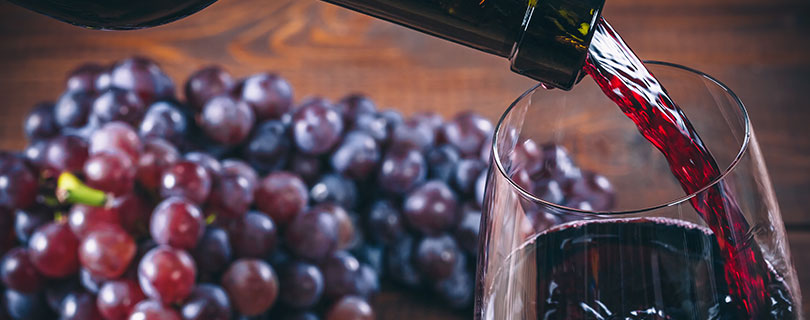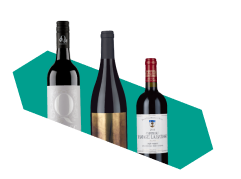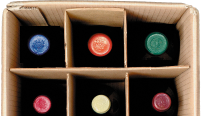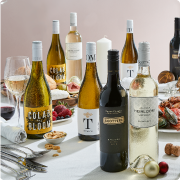Cabernet Sauvignon is one of the world’s most popular red wines – and for good reason! The famous grape is celebrated for its robust character and complex flavours. It is grown in almost every wine-producing region across the globe, including France, Moldova, the US, Chile, Australia, New Zealand and Argentina. Each country where it’s cultivated has its own unique style – and in the case of a country as broad and varied as Australia, there are many! – which means there is a diverse range of Cabernet Sauvignon wines to explore and enjoy.
Red wine lovers are drawn to Cabernet Sauvignon’s rich dark fruit flavours, firm tannins, complexity and refreshing acidity. Its adaptable nature makes it a versatile partner for pairing with a wide range of foods. Whether you’re enjoying your wine on its own or with a meal, Cabernet Sauvignon is popular with wine connoisseurs as well as those new to the world of wine.
What is Cabernet Sauvignon?
Originally from Bordeaux in France, Cabernet Sauvignon is one of the world’s most recognisable red wine grapes. Famous for its full body, firm tannins and high acidity, the wine features a complex palate of rich flavours. These typically include dark fruits such as blackcurrant and plum, often accompanied by a hint of spice or oak.
Incredibly versatile and adaptable, this variety is grown everywhere, from France to California and Australia to Chile. Each region adds its unique touch, so there’s a wide variety of styles for red wine lovers to explore. If you like bold, characterful reds, a glass of Cabernet Sauvignon is a must.
Where is Cabernet Sauvignon from?
Cabernet Sauvignon is a superstar grape variety grown in nearly every major wine region worldwide, but its roots can be traced back to the Bordeaux region of France. The result of a chance cross between Cabernet Franc and Sauvignon Blanc in the 17th century, this grape has since earned a reputation for producing full-bodied, complex wines that can age gracefully for decades.
Bordeaux remains a benchmark for premium Cabernet Sauvignon, particularly in the Left Bank regions, where the grape often takes centre stage in famous Bordeaux red blends. The wines here are known for their structured tannins, deep fruit flavours and incredible ageing potential.
Interested in Bordeaux wine? Read our expert guide to Bordeaux wine to get started.
Cabernet Sauvignon really began to shine on the international stage when it reached California, particularly Napa Valley. Here, winemakers create robust, fruit-forward wines with generous oak hints. Similarly, regions like Chile’s Maipo Valley and Argentina’s Mendoza produce quality Cabernet Sauvignon wines known for their vibrant fruitiness and softer, approachable style.
South Africa’s Stellenbosch region is another hotspot. This area creates wines that balance vibrant fruitiness with a classic, robust structure.
In Australia, the grape has several homes – regions such as Margaret River and Coonawarra are renowned for their exceptional Cabernet Sauvignon wines.
The grape was first planted in Coonawarra in the late 19th century, and it thrived in the unique terra rossa soil. However, the region became internationally recognised for its excellent Cabernet Sauvignon in the 1960s and 1970s.
Margaret River (home to ultra-premium Australian Cabernet Sauvignon and Chardonnay) is climatically very similar to Bordeaux – Cabernet Sauvignon was first planted there in the late 1960s.
In Western Australia, the Margaret River region benefits from maritime influences that produce Cabernets with concentrated black fruit flavours, herbal hints and smooth tannins. With its iron-rich, red ‘terra rossa’ clay soil, Coonawarra creates intense and elegant Cabernet Sauvignon wines, often with distinctive mint or eucalyptus notes.
Further north, the warm climate of Barossa Valley produces rich, full-bodied Cabernet Sauvignons with ripe, almost jammy fruit flavours.
Hawke’s Bay Cabernet Sauvignon wines in New Zealand have a cool-climate style and are often blended with Merlot.

How does climate affect Cabernet Sauvignon wines?
Climate plays a key role in defining the characteristics of every wine, including Cabernet Sauvignon. It can shape everything from the wine’s aromas and flavour to its body and ageing potential.
Cabernet Sauvignon grapes ripen fully and develop riper, richer fruit flavours in warmer climates, such as California’s Napa Valley or Australia’s Margaret River. You might detect notes of lush blackcurrant, blackberry or even chocolate. These wines often have a fuller body and smoother tannins, making them approachable at a younger age. The warmer conditions lead to higher sugar levels in the grapes, creating wines with a higher alcohol content.
But Cabernet Sauvignon from moderate or cooler regions like Bordeaux in France or South Australia’s Coonawarra often has more structured tannins and a vibrant acidity. These wines may have green flavours like capsicum and mint alongside the darker fruit notes and are known for their excellent ageing potential.

What does Cabernet Sauvignon taste like?
Cabernet Sauvignon is famous for its depth of flavour and complex layers of aromas. This variety typically has a concentrated core of dark fruit flavours, including blackcurrant, black cherry and plum. Its robust fruit notes are often supported by warming hints of spice and vanilla. Cabernet Sauvignon wines can have a distinctive savoury hint of green capsicum if the grapes are grown in a cooler climate.
It’s a full-bodied wine, with a rich, velvety texture that coats the tongue. Its pronounced acidity is fresh and vibrant, balancing out those intense fruit flavours. The wine is also known for its high alcohol levels, which can contribute to its overall bold and warming character.
A key aspect of Cabernet Sauvignon’s style is its tannins. These give the wine structure and longevity while delivering a pleasantly dry, grippy finish.
However, flavours can vary depending on the growing conditions and winemaking techniques. Warmer climates tend to produce wines with riper, sweeter fruit flavours, while wines from cooler climates typically have more savoury, herbal notes of rosemary and bay leaf. Oak ageing can also create additional layers of complexity, adding hints of toast, vanilla and spices.
Is Cabernet Sauvignon sweet or dry?
While it often has a juicy burst of sweet dark fruit flavours like blackcurrant and blackberry – particularly those from warmer climates – it is a dry red wine. The word ‘dry’ in the wine world means it has little to no residual sugar (the sugar left over after fermentation).
So, although the ripe fruit flavours might imply sweetness, Cabernet Sauvignon is not a sweet wine. Any perceived sweetness results from the grape’s fruity flavours rather than the wine’s sugar content.
Cabernet Sauvignon typically falls in the dry category. Its robust, fruity profile, firm tannins and crisp acidity create a well-balanced wine that is full of flavour without sugary sweetness.
Cabernet Sauvignon vs Shiraz – what’s the difference?
Although Cabernet Sauvignon and Shiraz (Syrah) are powerhouses in the red wine world, the two wines have strikingly different styles.
Cabernet Sauvignon thrives in wine regions such as Margaret River, Napa Valley and Bordeaux. It’s famous for its high tannin content and full-bodied nature. Bursting with dark fruit flavours such as blackcurrant and blackberry, it often has hints of cedar or vanilla from maturation in oak barrels. Its sturdy structure and high acidity make it a great partner for hearty dishes like steak or roast lamb.
Shiraz is a star of South Australia’s wine regions and is also grown in France’s Rhône Valley. In contrast to Cabernet Sauvinon, the grape typically creates full-bodied wines with riper dark fruit flavours, such as blackberry and plum. These are accompanied by spicy black pepper notes and a less pronounced acidity than Cabernet Sauvignon. Shiraz also typically has softer tannins and less pronounced acidity. Its bold, rich profile is ideal for pairing with peppery, spiced dishes and rich blue cheese.
Cabernet Sauvignon vs Merlot – what’s the difference?
Cabernet Sauvignon and Merlot each bring distinct styles and traits to the table.
Cabernet Sauvignon flourishes in Bordeaux’s moderate climate and in sunny South Australia, but the grape is widely planted worldwide. It creates full-bodied, tannic wines that boast a rich palate of dark bramble fruits and often carry cedar or vanilla notes from time in oak barrels. This bold, structured character makes it a wonderful companion to robust dishes such as lamb or steak.
Merlot is a softer, more approachable wine. The grape thrives in Bordeaux and other regions such as Tuscany, and Hunter Valley and Barossa Valley in Australia. Generally smoother and less tannic than Cabernet Sauvignon, Merlot offers a delightful range of red stone fruit flavours – think juicy cherry and plum – often with hints of chocolate or herbs. By contrast, Merlot is typically lower in tannins and has medium acidity, making it smoother and more medium-bodied than Cabernet Sauvignon. Its supple, rounded style is a versatile match for a variety of dishes, from roast chicken to chargrilled vegetables.
Together, these two varietals complement each other: Cabernet Sauvignon provides structure, tannins and depth, while Merlot offers softness, fruitiness and body. This is why they are often blended together.
Pinot Noir vs Cabernet Sauvignon – what’s the difference?
Cabernet Sauvignon and Pinot Noir are both incredibly popular red wines, but they have very different styles.
Cabernet Sauvignon is the world’s most planted red grape variety, thriving in various wine regions worldwide. It is known for its robust structure and high tannins. The wine tends to be full-bodied in style, with rich, dark fruit flavours like blackcurrant and plum, often accompanied by cedar or vanilla notes from oak ageing. Thanks to its robust character, Cabernet pairs very well with rich, hearty dishes like steak or lamb. Due to its robust structure and high tannin content, Cabernet Sauvignon often has a higher ageing potential than Pinot Noir, which is often enjoyed young.
Pinot Noir thrives in cool to moderate climates – Burgundy and New Zealand are prime locations for this variety. While Cabernet Sauvignon is a hardy grape with thick skins, Pinot Noir is thin-skinned and requires careful handling. This grape creates easier-drinking wines that are lighter in body and lower in tannins than Cabernet Sauvignon. Expect delightful flavours of red fruits like strawberries and raspberries alongside a distinctive earthy or floral note. This more delicate style makes Pinot Noir a versatile food wine – it can be a good match for dishes from grilled salmon to roast chicken.
How do I pair food with Cabernet Sauvignon?
Pairing a robust Cabernet Sauvignon with the right food can elevate a good meal into a feast. This full-bodied red wine is known for its high tannin content and bold flavours, making it an ideal partner for hearty, rich dishes.
For example, a glass harmonises well with a juicy ribeye steak, as the wine’s tannins act as a palate cleanser, cutting through the meat’s fattiness. The wine works well with roast beef in the same way – the tannins smooth over the meat’s texture, while the juicy dark fruit and herbal hints complement the meat’s natural flavours.

It’s perfect with a hearty casserole or stew, particularly one made with beef or lamb. The wine’s fruit notes can complement the depth of flavours in the dish, while its acidity helps balance the richness.
Regional Cabernet Sauvignon pairings include Agneau de Pauilla, a classic lamb dish from Bordeaux. The structured, fruit-forward wine is a wonderful match for the sweet, tender lamb.
Whether treating yourself to a steak dinner or enjoying a hearty, family-sized stew, a well-chosen Cabernet Sauvignon can take your meal to the next level.
Interested in food pairings? Read our guide to food and wine pairing basics to get started.
How do I best serve Cabernet Sauvignon?
This full-bodied red should be served at around 16-18°C so that its flavours and aromas are balanced and the alcohol doesn’t become overwhelming. If your bottle has been stored at room temperature, pop it in the fridge for 10-15 minutes before pouring.
Decanting is recommended before serving. This helps to aerate the wine, softening its tannins and releasing its deep aromas. A younger style of wine can benefit from decanting for 2-3 hours, while an older style won’t need more than 30 minutes to an hour.
A large, open, red wine glass is ideal, as it allows the wine’s aromas to open up.

How many calories are in a bottle of Cabernet Sauvignon?
While the exact number of calories in Cabernet Sauvignon can vary due to the wine’s alcohol content and residual sugar, a standard 750ml bottle typically contains 600-675 calories (around 2,670 kJ).
This means a standard 125ml serving has roughly 120-135 calories (around 534 kJ).
However, do remember that these are just average estimates. The exact calorie or kilojoule count can vary depending on the specific wine – sweeter or higher-alcohol styles of Cabernet Sauvignon typically contain more calories.
Can Cabernet Sauvignon be used in cooking?
Although enjoying a glass of Cabernet Sauvignon with a meal is best, cooking with Cabernet Sauvignon can add further complexity to your dish. Its robust character makes the wine a great addition to hearty stews and rich sauces, adding a beautiful depth of flavour. Always remember, when cooking with wine, the flavours intensify as it reduces – so be careful how much you use!
It’s best to use a good-quality wine you enjoy in your cooking. But don’t feel compelled to break the bank – an affordable, decent-quality Cabernet Sauvignon will do the job perfectly, enhancing your dishes with its full-bodied richness.
How long does Cabernet Sauvignon last unopened?
Unopened, a bottle can usually be stored for up to ten years or more, depending on the quality of the wine. This longevity is thanks to Cabernet’s high tannins, which act as preservatives.
However, proper storage is key – keep your bottle in a cool, dark place at a consistent temperature. Over time, an aged Cabernet Sauvignon evolves, so if your bottle is stored well, it can transform into an even more sophisticated wine. Older Cabernet Sauvignon wines have a more mellow fruitiness and develop new, complex flavours like leather and tobacco.
How long does Cabernet Sauvignon last after opening?
Once opened, a bottle of Cabernet Sauvignon can last 3-5 days before beginning to lose its charm. Several factors can influence this timeframe, including how well-sealed the bottle is and where it’s being kept.
For best results, reseal or recork it tightly – use a wine preserver for an airtight seal – and pop it in the fridge. Remember, fuller-bodied, tannic wines tend to last longer. It is known for its structure and tannins, so your wine can stay fresh until the five-day mark.
What are the best Cabernet Sauvignon wines?
Hamilton Block By Leconfield Coonawarra Cabernet Sauvignon 2020
After a full-bodied and powerful Cabernet Sauvignon? Hamilton Block By Leconfield Coonawarra Cabernet Sauvignon 2020 is the one for you. This beautifully balanced South Australian red has aromas of blackcurrant, dark plum and wild herbs, plus subtle hints of cedar from oak-ageing. Pair a glass with lamb chops drizzled with mint sauce or a cheeseboard featuring aged Cheddar, Gorgonzola and Gouda.
The Black Pig Reserve McLaren Vale Cabernet Sauvignon 2023
The Black Pig Reserve McLaren Vale Cabernet Sauvignon 2023 offers rich flavors of blackcurrant, dark cherries, and hints of tobacco, with firm tannins and a long, smooth finish. It pairs excellently with grilled steaks, roasted lamb, and aged cheeses like cheddar or Gruyère.
The Prophet By Chapel Hill McLaren Vale Cabernet Sauvignon 2020
A prime example of McLaren Vale Cabernet Sauvignon, The Prophet By Chapel Hill McLaren Vale Cabernet Sauvignon 2020 is rich, chocolatey and velvety. This beautifully structured and complex red has expressive notes of blackcurrant, blueberry, bay leaf, rosemary, cigar box and chocolate. Pair this lavish Cabernet Sauvignon with roast beef or venison.
Allegiance Wines 'The Forman' Coonawarra Cabernet Sauvignon 2022
The Allegiance Wines 'The Foreman' Coonawarra Cabernet Sauvignon 2022 features flavours of dark berries, cassis, and subtle mint, with velvety tannins and a long, elegant finish. It pairs beautifully with grilled lamb, rib-eye steak, and aged cheeses like cheddar or gouda. For a delicious contrast, try it with roasted vegetables or charcuterie for a balanced and flavourful experience.
Belle Roche Cabernet Sauvignon 2022
If you’re after a taste of southern France, Belle Roche Cabernet Sauvignon 2022 is the Cabernet Sauvignon for you. This dense, claret-like red is packed with ripe blackcurrant notes, hints of mint and toasty notes. This decadent wine is so dark in colour that it’s referred to as the winemaker’s ‘black diamond’ of this vintage. Pair a glass with a juicy steak, a rich lasagne or a hearty casserole.


















